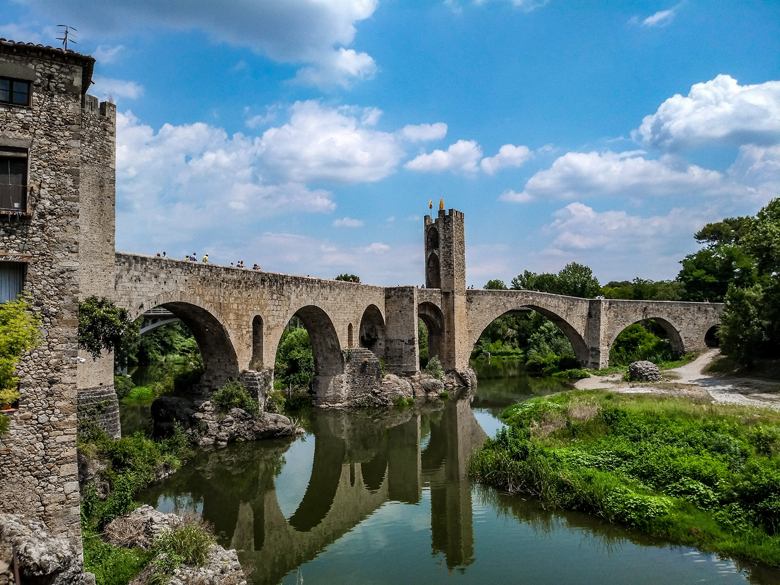The Besalú bridge is a is a Romanesque fortified entrance bridge that is located in Besalú -Girona,Catalonia,Spain.
There was probably a bridge at this point as early as Roman times. It is first mentioned in the documents in 1075. In 1284 the bridge was mentioned again in a document in connection with the sale of an orchard, although the bridge was probably located more upstream in the past, where the remains of pillars can still be seen, which are similar to the current bridge that consists of three sections, which are supported together by eight arches made of ashlar stones, with the sections at an angle to each other in plan.
There was probably a bridge at this point as early as Roman times. It is first mentioned in the documents in 1075. In 1284 the bridge was mentioned again in a document in connection with the sale of an orchard, although the bridge was probably located more upstream in the past, where the remains of pillars can still be seen, which are similar to the current bridge that consists of three sections, which are supported together by eight arches made of ashlar stones, with the sections at an angle to each other in plan.
The arches have different spans and are supported by rocks in the river bed. A gate on the city side ensures access to the city. At the end of the westernmost section with four arches, the street is widened to a large square so that traffic could cross, after two more arches there is a smaller square to cross . The hexagonal tower with the portcullis is located between the two crossing points.
The bridge of Besalú, on the river Fluvià, is the result of several reconstructions, reforms, additions and restorations, done over the centuries.In 1880 the tower in the center and the access portal from the village were demolished to facilitate the passage of machinery necessary for the local industry. Two bows were blown up in 1939
Today The Besalú bridge which can only be used by pedestrians It is listed as an Asset of Cultural Interest at the national level and at the regional level as a Cultural Asset of National Interest, by the authorities of Catalonia.
The bridge of Besalú, on the river Fluvià, is the result of several reconstructions, reforms, additions and restorations, done over the centuries.In 1880 the tower in the center and the access portal from the village were demolished to facilitate the passage of machinery necessary for the local industry. Two bows were blown up in 1939
Today The Besalú bridge which can only be used by pedestrians It is listed as an Asset of Cultural Interest at the national level and at the regional level as a Cultural Asset of National Interest, by the authorities of Catalonia.
Access : Coordinates: 42.199361, 2.701528 / you can go by plane to Barcelona and then from there take a train or bus to Girona, and then go to Besalú.Between Barcelona and Besalú there are 132 km that take less two hours, Via C-17 towards Vic with € 1.75 tolls
Via AP-7 towards Girona with € 10.20 tolls / By bus. With a frequency of 3 times a day, it is possible to go to Besalú from Barcelona.
Contents
The Besalú bridge is a is a Romanesque fortified entrance bridge that is located in Besalú -Girona,Catalonia,Spain.
There was probably a bridge at this point as early as Roman times. It is first mentioned in the documents in 1075. In 1284 the bridge was mentioned again in a document in connection with the sale of an orchard, although the bridge was probably located more upstream in the past, where the remains of pillars can still be seen, which are similar to the current bridge that consists of three sections, which are supported together by eight arches made of ashlar stones, with the sections at an angle to each other in plan.The arches have different spans and are supported by rocks in the river bed. A gate on the city side ensures access to the city. At the end of the westernmost section with four arches, the street is widened to a large square so that traffic could cross, after two more arches there is a smaller square to cross . The hexagonal tower with the portcullis is located between the two crossing points.
The bridge of Besalú, on the river Fluvià, is the result of several reconstructions, reforms, additions and restorations, done over the centuries.In 1880 the tower in the center and the access portal from the village were demolished to facilitate the passage of machinery necessary for the local industry. Two bows were blown up in 1939
Today The Besalú bridge which can only be used by pedestrians It is listed as an Asset of Cultural Interest at the national level and at the regional level as a Cultural Asset of National Interest, by the authorities of Catalonia.
Highlights :
- The medieval arch bridge over the River Fluvià has been a protected monument since 1949.
- The oldest part of the bridge, which dates from the 11th or 12th century, is on the city side.
- The total length of the bridge is 135 meters, with a deck width of 4 meters and a height of 15 meters to the ground.
- In 1881 there was no longer the tower or the front door, and during the Spanish Civil War it was blown up. It was between the 50s and 60s of the twentieth century when it was rebuilt by the Directorate General of Architecture.
Activities : sightseeing / photo opportunities / Good place to glance history!!
Go next : Besalú : A placid medieval town on the inland Costa Brava that has become one of the most visited in the province of Girona due to its undeniable beauty.

